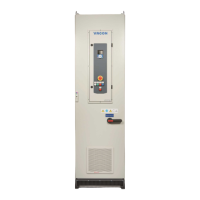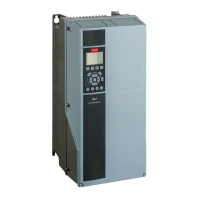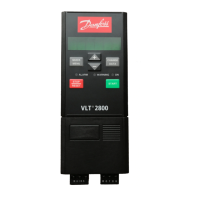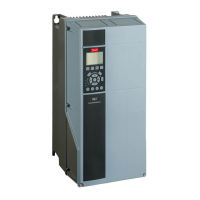Emergency
stop switch
Button/Device used
to give the
acknowledgement *
STO
Ack.
X4-11 (DIN1A)
X4-12 (DIN1B)
X3-9 (+24 V)
X4-13 (DIN2A)
X4-14 (DIN2B)
Advanced safety
option board
X3-1 (STO 1)
X3-2 (STO 2)
STO
option board
OPTAF
STO
X3-3 (GND)
X3-4 (GND)
SD2+
SD1+
SD2-
SD1-
e30bi379.10
Illustration 77: Emergency Stop Configuration with the STO Function and Safe Acknowledgment
* = For some devices used for acknowledgment, additional wiring is required.
13.3 SS1 Used with STO(+SBC)
This is a configuration with the SS1 function and the STO function used with the SBC function in the Advanced safety option board
OPTBL. No external safe reset or acknowledgment is required. The STO function is not directly requested externally. The drive reset
is used to deactivate the STO function and to reset the faults.
The SS1 function is used in the time monitoring mode with a 4.75 s delay for the STO+SBC function activation. The SS1 function can
operate in the automatic or the manual acknowledgment mode with the drive acknowledgment enabled. The SBC function is acti-
vated before the STO function, and the delay between the SBC function and the STO function is 250 ms. In practice, the STO func-
tion becomes active 5 s after the SS1 function is requested. The 250 ms is the value that is assumed for the mechanical delay and
other delays in brake activation. The brake and the STO function are intended to become active at the same time. The parameter
SBC Speed is not used.
The SS1 request is assigned to Digital Input 1 of the Advanced safety option board. The SBC output is assigned to Digital Output 1 of
the option board. Monitoring of the ramp is not considered a safety critical feature. No safe speed measurement is necessary or is
not considered for this configuration.
The drive application is used to execute the SS1 controlled ramp to zero.
Table 102: Configuration in OPTBL: Used Safety Functions: SS1, STO+SBC
Acknowledgment Mode (STO)
AQ319736045637en-000101 / DPD01798174 | Danfoss A/S © 2021.06
Configuration Examples
VACON® NXP Advanced Safety Options
Operating Guide

